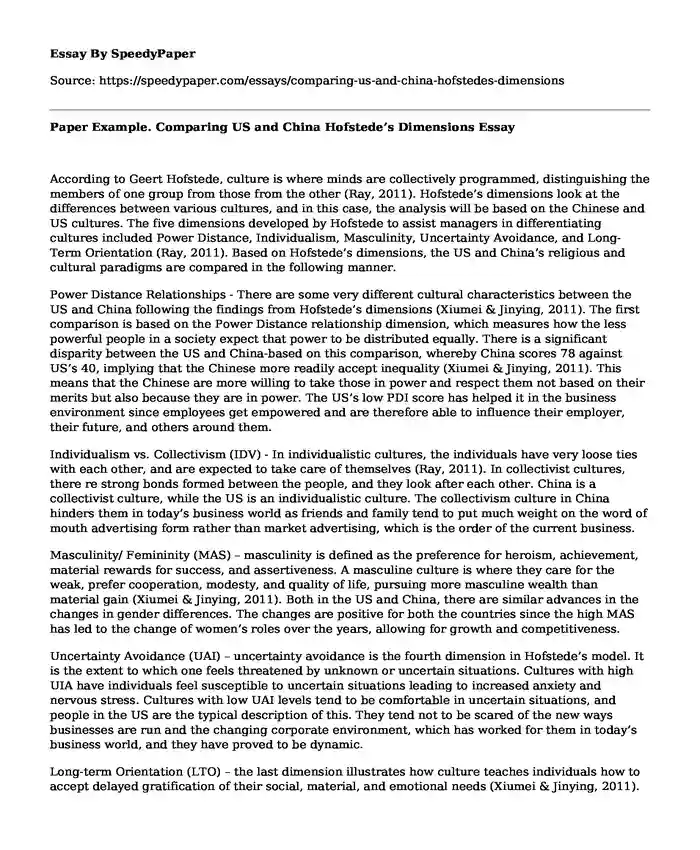
| Essay type: | Compare and contrast |
| Categories: | United States Asia Comparative literature |
| Pages: | 3 |
| Wordcount: | 693 words |
According to Geert Hofstede, culture is where minds are collectively programmed, distinguishing the members of one group from those from the other (Ray, 2011). Hofstede’s dimensions look at the differences between various cultures, and in this case, the analysis will be based on the Chinese and US cultures. The five dimensions developed by Hofstede to assist managers in differentiating cultures included Power Distance, Individualism, Masculinity, Uncertainty Avoidance, and Long-Term Orientation (Ray, 2011). Based on Hofstede’s dimensions, the US and China’s religious and cultural paradigms are compared in the following manner.
Power Distance Relationships - There are some very different cultural characteristics between the US and China following the findings from Hofstede’s dimensions (Xiumei & Jinying, 2011). The first comparison is based on the Power Distance relationship dimension, which measures how the less powerful people in a society expect that power to be distributed equally. There is a significant disparity between the US and China-based on this comparison, whereby China scores 78 against US’s 40, implying that the Chinese more readily accept inequality (Xiumei & Jinying, 2011). This means that the Chinese are more willing to take those in power and respect them not based on their merits but also because they are in power. The US’s low PDI score has helped it in the business environment since employees get empowered and are therefore able to influence their employer, their future, and others around them.
Individualism vs. Collectivism (IDV) - In individualistic cultures, the individuals have very loose ties with each other, and are expected to take care of themselves (Ray, 2011). In collectivist cultures, there re strong bonds formed between the people, and they look after each other. China is a collectivist culture, while the US is an individualistic culture. The collectivism culture in China hinders them in today’s business world as friends and family tend to put much weight on the word of mouth advertising form rather than market advertising, which is the order of the current business.
Masculinity/ Femininity (MAS) – masculinity is defined as the preference for heroism, achievement, material rewards for success, and assertiveness. A masculine culture is where they care for the weak, prefer cooperation, modesty, and quality of life, pursuing more masculine wealth than material gain (Xiumei & Jinying, 2011). Both in the US and China, there are similar advances in the changes in gender differences. The changes are positive for both the countries since the high MAS has led to the change of women’s roles over the years, allowing for growth and competitiveness.
Uncertainty Avoidance (UAI) – uncertainty avoidance is the fourth dimension in Hofstede’s model. It is the extent to which one feels threatened by unknown or uncertain situations. Cultures with high UIA have individuals feel susceptible to uncertain situations leading to increased anxiety and nervous stress. Cultures with low UAI levels tend to be comfortable in uncertain situations, and people in the US are the typical description of this. They tend not to be scared of the new ways businesses are run and the changing corporate environment, which has worked for them in today’s business world, and they have proved to be dynamic.
Long-term Orientation (LTO) – the last dimension illustrates how culture teaches individuals how to accept delayed gratification of their social, material, and emotional needs (Xiumei & Jinying, 2011). A culture with lower levels of LTO expects immediate gratification and needs quick satisfaction to their desires. The dimension has an influential association with a nation’s propensity to invest, save, and per capita income growth. China has a very high LTO, while the US has a very short-term orientation (STO) (Xiumei & Jinying, 2011). This implies that in the US, most of the companies focus on short term goals such as this year’s or quarter’s profits, and this has worked for them in the current business world where short-term goals are essential for business success.
References
Ray, J. (2011). Cultural Comparison of the United States and China from the Project Manager's Perspective. Available at SSRN 2104458. https://www.researchgate.net/profile/Jeffrey_Ray3/publication/256024416_Cultural_Comparison_of_the_United_States_and_China_from_the_Project_Manager%27s_Perspective/links/5b14728c0f7e9b498108e478/Cultural-Comparison-of-the-United-States-and-China-from-the-Project-Managers-Perspective.pdf?origin=publication_detail
Xiumei, S. H. I., & Jinying, W. A. N. G. (2011). Cultural distance between China and US across GLOBE model and Hofstede model. International Business and Management, 2(1), 11-17. https://scholar.google.com/scholar_url?url=http://52.196.142.242/index.php/ibm/article/view/j.ibm.1923842820110201.004&hl=en&sa=T&oi=gsb&ct=res&cd=0&d=11087597841706643130&ei=TAQFX-K8HI-omQGFzYSYAg&scisig=AAGBfm36q0l2paKQB7S833sFFANYWBueMA
Cite this page
Paper Example. Comparing US and China Hofstede's Dimensions. (2023, Sep 25). Retrieved from https://speedypaper.net/essays/comparing-us-and-china-hofstedes-dimensions
Request Removal
If you are the original author of this essay and no longer wish to have it published on the SpeedyPaper website, please click below to request its removal:
- Womens suffrage
- Analysis of Psycho Novel and Movie in a Free Essay
- Industrialization of Multinational Enterprises, Essay Sample for Everyone
- Heart of Darkness, Literary Analysis Essay Sample
- Free Essay Example: Banking in the Early Development of United States
- Comparative Analysis: "The Dead of September 11". Essay Sample
- Paper Example on American Indian Identity
Popular categories




